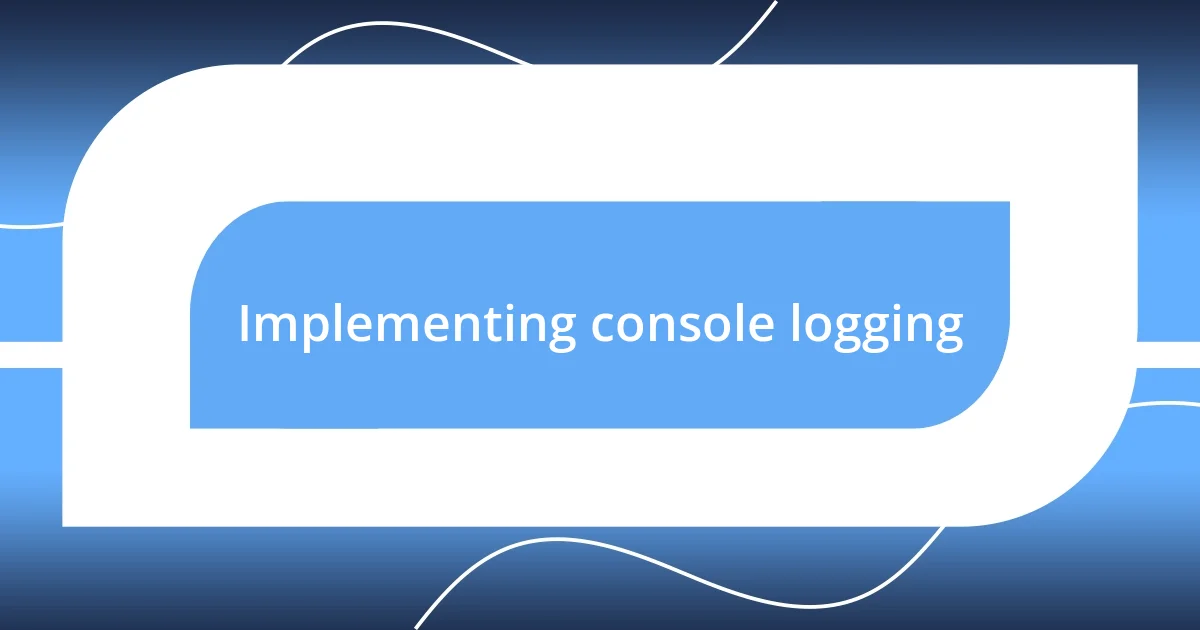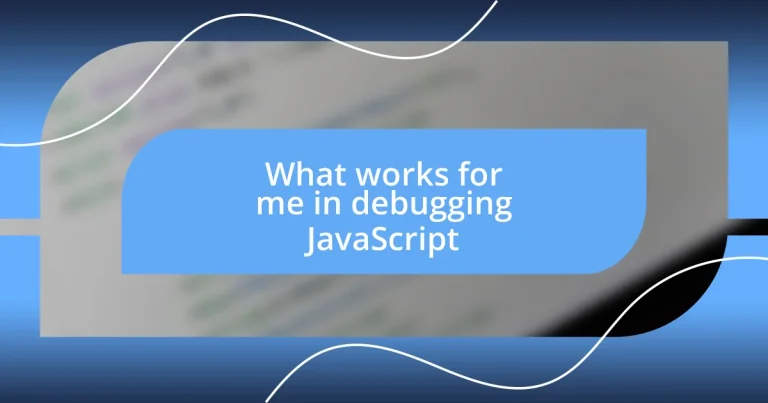Key takeaways:
- Utilizing console logging and debugging tools like Chrome DevTools significantly enhances code visibility, helping developers quickly pinpoint issues and optimize performance.
- Understanding common JavaScript errors and structuring code clearly with modular functions and comments greatly aids in debugging efficiency and reduces frustration.
- Documenting the debugging process and learning from mistakes fosters a deeper understanding of coding practices and encourages collaboration with peers for problem-solving.

Effective debugging techniques
One effective debugging technique I’ve found particularly helpful is using the console extensively. I remember a time when I was stumped by a seemingly endless loop in my code. After adding console.log() statements, I discovered that one of my conditions was never being met due to a simple typo. It really drove home the point that sometimes, the answer is just a line or two away from being visible.
Another technique I often rely on is isolating issues by simplifying the code. I vividly recall a project where I decided to comment out sections one by one. It was a methodical approach that helped me pinpoint exactly where things were going awry. This not only saved me time but gave me a sense of control over what felt like an overwhelming problem. Have you ever tried breaking your code down like this? It can be a real game changer.
Using debugging tools like breakpoints also enhances my workflow significantly. I remember the first time I used Chrome DevTools to step through my code—it was like opening a treasure chest of insights. Suddenly, I could see the flow of execution in real-time. This visibility not only improves understanding but also allows for a deeper connection with the code. Isn’t it amazing how technology can turn a frustrating experience into an enlightening one?

Understanding common errors
Understanding common errors in JavaScript is crucial for becoming an effective developer. There have been times when I’ve spent hours tracking down what I thought was a complex problem, only to realize it was a straightforward syntax error. It’s frustrating, but it happens to everyone. Debugging is as much about understanding these common pitfalls as it is about fixing them.
Here’s a quick list of typical errors I’ve encountered:
- Syntax Errors: These are mistakes like missing brackets or semicolons. They can easily throw a wrench in the works.
- Reference Errors: I remember a moment when I referred to a variable before declaring it. It was infuriating to untangle that one!
- Type Errors: This can happen when you try to perform operations on incompatible types, like adding a string to a number. I’ll never forget how often I faced this early in my JavaScript journey.
- Logical Errors: These are particularly sneaky; the code runs without crashing, but it doesn’t produce the right outcome. I once spent days debugging a function, only to realize I was using the wrong variable in a calculation.
Recognizing these errors early can save a significant amount of time and sanity. It can feel like a personal victory each time I spot a mistake before it spirals out of control. Debugging is a blend of patience, skills, and a keen eye for detail.

Utilizing developer tools
Utilizing developer tools has been a game changer in my debugging process. One of the first tools I dive into is the Chrome DevTools. The powerful Elements and Console panels allow me to inspect the DOM and track how my JavaScript interacts with it. I had a moment when I struggled with a layout that broke only in specific browsers. After using the Styles panel to tweak properties on the fly, I was able to see immediate results. It felt like I was conducting an experiment right there, and it opened my eyes to just how dynamic web development can be.
In addition to that, I’ve found that the Network panel is invaluable when dealing with asynchronous operations and API calls. I vividly remember debugging a frustrating situation where my REST API call was returning a 404 error. By investigating the headers and responses in the Network panel, I quickly pinpointed that the issue stemmed from a typo in the URL. It’s rewarding to know that these tools provide me the clarity that often saves me from spiraling into confusion.
Another essential feature is the JavaScript profiler. I like to run performance checks to see where my code can be optimized. There was a time when my application was running slowly, and using the profiler revealed that a particular function was taking over a second to execute. By analyzing the profiler’s output, I was able to refactor the code into a more efficient form. It’s these small victories that remind me why I enjoy debugging; it’s not just about fixing what’s broken, but improving what’s there.
| Developer Tool | Description |
|---|---|
| Chrome DevTools | Inspect and edit HTML/CSS, monitor console logs, and debug JavaScript. |
| Network Panel | Monitor network requests and responses, troubleshoot API issues. |
| JavaScript Profiler | Analyze performance of JavaScript, identify slow functions for optimization. |

Implementing console logging
When it comes to implementing console logging, I’ve found that it’s one of the simplest yet most effective tools in my debugging arsenal. I still remember the first time I started using console.log(); it was like flipping a light switch in a dark room. By logging values at various stages of my code execution, I could follow the flow of data and instantly identify where things were going wrong. Have you ever experienced that “aha” moment? When you see your output displayed exactly as you expected it, it’s incredibly satisfying!
Another tip I often share is to use other methods of the console, like console.error(), console.warn(), or console.table(). Each has its own charm and utility. I was once debugging an array of data where I thought my logic was flawless, yet the output failed to meet my expectations. By implementing console.table(), I was able to visualize the array in a structured format, which made spotting discrepancies much easier. There’s a certain thrill in having the right tool to simplify complex data representation!
I’ve also learned that it’s not just about printing values but strategically placing logs. For instance, I’ve had instances where I buried a console.log() within a deeply nested function. This often led to confusion instead of clarity. Reflecting on it now, it makes me wonder—how often do we forget that being methodical in our approach can yield clearer insights? I’ve adopted a practice of placing logs at the start and end of functions, marking key decisions along the way. This simple habit has truly transformed my debugging experience, turning frustration into clarity.

Structuring your code for clarity
When I think about structuring code for clarity, I can’t help but reflect on my early days of programming when I would shove every piece of logic into one long function. It was a tangled mess. I quickly learned that breaking my code into modular functions not only improved readability but also made debugging so much easier. Have you ever felt overwhelmed trying to navigate through a lengthy block of code? I certainly have, and introducing functions with descriptive names helped turn those intimidating chunks into digestible pieces I could manage with confidence.
Comments play a vital role in my coding process as well. Detailed comments at the start of each function serve as a mini-guide for anyone (including my future self) who might revisit the code later. I recall hitting a wall on a project where I had to revisit my work after a few weeks. The clear comments reminded me of my thought process and showed me exactly how everything was meant to fit together. It’s fascinating how a few extra words can bridge the gap between confusion and clarity.
Additionally, I’ve found that formatting is crucial; consistent indentation and spacing help maintain an organized appearance. It’s almost like arranging your workspace; when everything is tidy and in its place, it’s much easier to focus. I remember once, while working on a collaborative project, I neglected to follow formatting conventions. That led to a frustrating back-and-forth in code reviews. Now, every line of code feels like a part of a larger story, and I tie everything together with clear structure, which invites collaboration rather than confusion. Isn’t it amazing how a little bit of order can open the door to better teamwork?

Using breakpoints strategically
Using breakpoints strategically can truly elevate your debugging game. I vividly recall a time when I was caught in a seemingly never-ending loop, and it felt like I was chasing my own tail. By placing breakpoints at key locations, I was able to pause execution and inspect the state of my application in real-time. It was eye-opening to see how variables changed at different stages and pinpoint exactly when things went awry. Don’t you find it comforting when you can take a step back and see the bigger picture?
I also learned the value of conditional breakpoints, which allow me to halt execution only when specific criteria are met. One day, while tackling a complex user authentication feature, I realized I could set a breakpoint that triggered only when a user’s role was incorrectly assigned. This not only saved me a ton of time but also made my debugging process feel more targeted and effective. Have you ever wished you could skip over all the noise and home in on just the heart of the issue? Conditional breakpoints allow you to do just that!
Thinking about stepping away and giving your mind a break can be revolutionary too. There have been countless moments when I would stare at my screen, convinced I missed something obvious. Taking a short break after strategically setting breakpoints often helps clear my head. When I return, I approach the code with fresh eyes, which sometimes leads to sudden clarity. Isn’t it interesting how a little distance can inject new perspective into a challenge?

Learning from debugging experiences
Reflecting on my debugging experiences, I’ve come to realize just how valuable mistakes can be. Early on, I encountered a bug that took me hours to solve, only to find out it was a simple typo. That moment was humbling; it drove home the importance of patience and attention to detail. Have you ever been frustrated by a trivial error only to laugh at yourself later? I certainly have, and now, I approach each bug as a learning opportunity rather than a setback.
One lesson I’ve learned is the importance of documenting my debugging process. There was a time when I tackled a particularly stubborn issue without tracking my steps, and when the same problem resurfaced later, I was stumped. Since then, I started keeping a debugging journal where I jot down errors, hypotheses, and solutions. This practice not only helps me remember what worked but also fosters a deeper understanding of my code. Does jotting down your thought process resonate with you? It’s made a world of difference for me.
I also cherish the moments of camaraderie that arise from shared debugging experiences with my peers. Whenever I’ve reached out for help, I’ve noticed it often leads to interesting conversations that not only unravel the issue at hand but also spark new ideas for future projects. It feels empowering to connect with others over challenges we face together. Have you experienced that collaborative spark? For me, those discussions transform bugs from solitary struggles into opportunities for growth and innovation.














